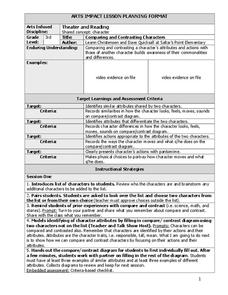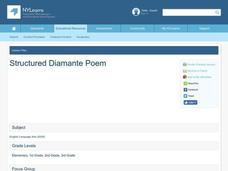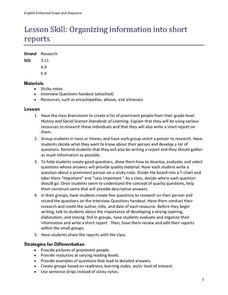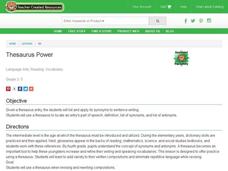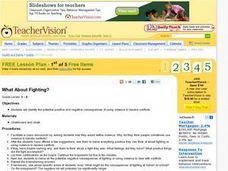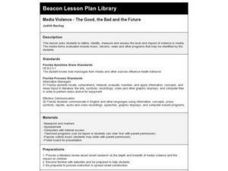Curated OER
Character in a Bag
Develop a mystery character using clues from a bag. This engaging activity will help learners understand character traits. They develop a list of the items from the bag, discuss and develop the character with a partner, and create a...
Curated OER
What Makes Our Community Special?
Explore websites, complete research, and use technological tools to create a final multimedia presentation on what makes a community special. Learners of all ages work with a partner to research an interesting aspect of their community,...
Curated OER
Character Study
Third graders work in pairs to choose two characters and find their similarities and differences. In this character instructional activity, 3rd graders compare characters by their actions and attributes. Students individually...
Curated OER
Structured Diamante Poem
Youngsters review nouns, adjectives and verbs. In this poetry lesson, readers choose a set of antonyms and create a list of synonyms, verbs and adjective for each. Students use the words to write a Diamante poem.
Curated OER
Fossils 2: Uncovering the Facts
Students determine what types of information can be determined by looking at fossils. In this fossil lesson, students examine facts about and images of the Tyrannosaurus Rex at an assigned web site. They apply their knowledge to develop...
Curated OER
Organizing Info into Short Reports
The class brainstorms a list of prominent people from their knowledge of social studies. Groups of two pupils get together and select one of these people to research. They create five questions to research on their person and record them...
Berkshire Museum
Camouflage!: Collecting Data and Concealing Color
Help young scholars see the important role camouflage plays in the survival of animals with a fun science lesson. Starting with an outdoor activity, children take on the role of hungry birds as they search for worms represented by...
Curated OER
Thesaurus Power
Give your class the advantage of Thesaurus Power! They will use a thesaurus to understand word meanings and relationships. They focus on how a thesaurus functions and how it gives the entry word, definition, synonyms, antonyms, and part...
Curated OER
Symmetry in Children's Art Experiences
Read between the lines of symmetry to make important connections between math, art, culture, and nature.
Curated OER
Acting for the Common Goods
The first of a three-part series on bullying, this plan has class members present skits about bullying, write and sign an anti-bullying pledge, and complete a service project. For the skit, learners use information from previous lessons...
Media Literacy
Once Upon a Time
Robert Munsch's The Paperbag Princess and Jon Scieszkafrom's The True Story of the Three Little Pigs launch a discussion of the role of stereotypes in stories and movies.
Curated OER
A Leopard Doesn’t Change Its Spots
First, introduce rank badges, which were used during the Qing Dynasty. Then, the class will work together to uncover the meaning of the images they see. They'll examine and research the meaning behind the symbols found on Leopard Rank...
Film Education
The Jungle Book
Accompany a viewing of Disney's live-action feature film, The Jungle Book, with a packet equipped with several activities focused on story elements. Scholars discuss and complete diagrams and charts about the movie's characters, setting,...
Curated OER
Lesson 3: Measuring Angles
Young scholars use a protractor to measure angles. They classify angles by type: right angle, acute angles, and obtuse angles. Students build and draw right, acute, and obtuse angles. They discuss how do people in various professions use...
Curated OER
How Do I Get There? Planning a Safe Route to School
One much-needed skill for young learners is direction giving. Have your class plan and draw a safe route for them to travel from home to school. They will also draw places and items that are in between home and school in order to build a...
Curated OER
What About Fighting?
What are the positive and negative consequences of violence? Elementary and middle schoolers discuss how some see violence as the answer to resolving conflicts. They identify the positive and negative aspects to using violence, and ask...
Curated OER
Is Your Money Rolling Away?
Young scholars demonstrate how to solve word problems. They will watch the video "Math Can Take You Places" and identify three problem solving strategies.
Curated OER
Look for Patterns: Quilts in Two Faith Ringgold Stories
Author Faith Ringgold uses quilts to illustrate her books Tar Beach and Aunt Harriet's Underground Railroad. In this integrated trio of activities, young scholars read stories, identify and create patterns, and design quilt squares of...
Curated OER
Media Violence - The Good, the Bad and the Future
Third graders define, identify, measure, and assess the level and impact of violence in media. The media forms evaluated include music, sitcoms, news, and other programs that are identified and shared by the class.
Curated OER
Functional Homes
Students observe and reflect on habitats built and used by various life forms. They discover the benefits of the "homes" to the creature and its life and apply the natural designs to human uses.
Curated OER
Teaching Grammar in Context: Using Sentence Combining to Teach Subordination
Reinforce sentence styles with this lesson, which prompts young grammarians to build complex and compound-complex sentence structures. They respond to non-print text and identify subordinators as parts of speech procedure. They spell...
Curated OER
Traveling Community Journal Project
Students create an online "community journal". In this communities lesson, students use a writing template to send e-mail to various people to learn more about their community. The journal is passed from person to person.
Curated OER
New School Mural
Young muralists use digital images they take of buildings, locations, landmarks, or places inside the school to create an original work of art. After locating sites of importance and researching to find information, members try to...
Curated OER
Mural Mania
Learn about your home state. After listening to stories about your state, identifying symbols, and discussing what makes your region special, your class creates a mural.


